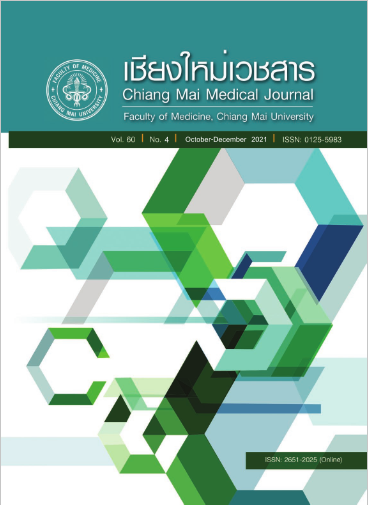Prevalence and related factors of musculoskeletal discomfort among workers in a frozen seafood factory in Samut Songkhram Province
Keywords:
Prevalence, Musculoskeletal discomfort, Ergonomic assessment, Production workers in a frozen seafood factoryAbstract
Objectives This study aimed to investigate the prevalence and related factors of musculoskeletal discomfort (MSD) among workers in a frozen seafood factory in Samut Songkhram Province.
Methods The study design was a cross-sectional descriptive study in all 524 recruited seafood production workers, without randomization. Data were collected using general questionnaires and Standardised Nordic Questionnaires in Thai version, which the researcher and the language interpreter conducted interviews with all the samples by themselves. Data were analyzed by descriptive statistics and multiple logistic regression analysis.
Results The prevalence of overall musculoskeletal discomfort (discomfort in at least one part of the body) in seafood production workers within the last 7 days, the last 12 months and the last 12 months that affected works were 36.83%, 55.34% and 26.90%, respectively. The lower back was the area with the highest prevalence of MSD, followed by shoulder. Factors related to musculo-skeletal discomfort were having a high level of education, increasing income, having underlying disease, drinking alcohol and repetitive work pattern (Slicing, Trimming and Packing).
Conclusion The musculoskeletal discomfort was rather highly prevalent in all body parts of seafood production workers. Health promotion, education and correct ergonomic posture should be provided to reduce the prevalence of MSD and work risks.
References
Occupational and Environmental Health Profile. Guidelines for providing occupational health services to community workers in ergonomics for primary health unit service personnel. Bangkok: Occupational and Environmental Health Profile; 2017. (in Thai)
Supapong S. Occupational health. Bangkok: Chulalongkorn University press; 2021. (in Thai)
Tomita S, Arphorn S, Muto T, Koetkhlai K, Naing SS, Chaikittiporn C. Prevalence and risk factors of low back pain among Thai and Myanmar migrant seafood processing factory workers in Samut Sakorn Province, Thailand. Ind Health. 2010;48:283-91.
Thetkhathuek A. Cold hazards and health effects in frozen food manufacturing. Naresuan Univeristy Journal: Science and Technology. 2014;22:26-34. (in Thai)
Soe KT, Laosee O, Limsatchapanich S, Rattanapan C. Prevalence and risk factors of musculoskeletal disorders among Myanmar migrant workers in Thai seafood industries. Int J Occup Saf Ergon. 2015;21:539-46.
Social Security Office. Occupational injury or illness statistics Classified by severity and disease occurring according to the nature or condition of the job [Internet]. 2019 [cited 2020 Nov 19]. Available from: https://www.sso.go.th/wpr/assets/upload/files_storage/sso_th/ae73d7aa3984d1af0965311ea1a9508e.pdf. (in Thai)
Department of Industrial Works. The statistics of the number of factories that are permitted to operate under the Factory Act B.E. 2535 classified by type [Internet]. 2019 [cited 2020 Nov 19]. Available from: https://www.diw.go.th/hawk/content.php?mode=spss63. (in Thai)
Samutsongkhram Technical College. Basic provincial economic and social information [Internet]. 2020 [cited 2020 Nov 25]. Available from: http://www.sstc.ac.th/data_1548. (in Thai)
Department of Industrial Works. The statistics of the number of factories that are permitted to operate under the Factory Act B.E. 2535 classified by provinces [Internet]. 2019 [cited 2020 Nov 19]. Available from: https://www.diw.go.th/hawk/content.php?mode=spss63. (in Thai)
Pinyowiwat K. Comparisons of the result from ergonomic evaluation tools between Rapid entire body assessment (REBA) and Quick exposure check (QEC) in a steel factory [dissertation]. Bangkok: Chulalongkorn University; 2018. (in Thai)
Ohlsson K, Hansson GA, Balogh I, Strömberg U, Pålsson B, Nordander C, et al. Disorders of the neck and upper limbs in women in the fish processing industry. Occup Environ Med. 1994;51:826-32.
Dovrat E, Katz-Leurer M. Cold exposure and low back pain in store workers in Israel. Am J Ind Med. 2007;50:626-31.
Wongsirisathawon T, Sithisarankul P. Prevalence and related factors of musculoskeletal discomfort among broker officers in Bangkok. Royal Thai Army Medical Journal. 2019;72:227-35. (in Thai)
Douloumpakas I, Pyrpasopoulou A, Triantafyllou A, Sampanis C, Aslanidis S. Prevalence of musculoskeletal disorders in patients with type 2 diabetes mellitus: a pilot study. Hippokratia. 2007;11:216.
Thetkathuek A, Meepradit P, Jaidee W. Factors affecting the musculoskeletal disorders of workers in the frozen food manufacturing factories in Thailand. Int J Occup Saf Ergon. 2016;22:49-56.
American Addiction Centers. How Substance Abuse Affects the Musculoskeletal System [Internet]. 2020 [cited 2021Jul13] Available from: https://sunrisehouse.com/addiction-demographics/musculoskeletal-system/.
MAX-PLANCK-GESELLSCHAFT. Muscle cells need calcium ions [Internet]. 2019 [ cited 2021 Jul 13]. Available from:https://www.mpg.de/14590554/muscle-cells-need-calcium-ions.
Downloads
Published
How to Cite
Issue
Section
License

This work is licensed under a Creative Commons Attribution-NonCommercial-NoDerivatives 4.0 International License.










